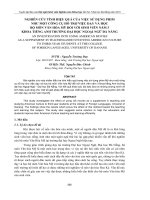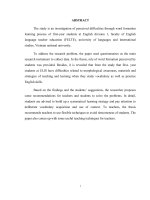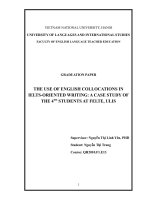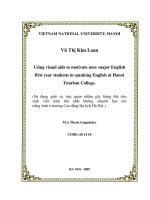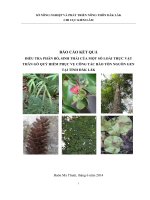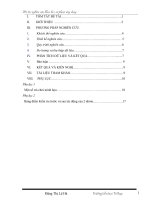VIỆC SỬ DỤNG CÁCH KẾT HỢP TỪ TRONG KỸ NĂNG VIẾT IELTS ĐỐI VỚI SINH VIÊN NĂM TƯ KHOA SƯ PHẠM TIẾNG ANH
Bạn đang xem bản rút gọn của tài liệu. Xem và tải ngay bản đầy đủ của tài liệu tại đây (316.29 KB, 57 trang )
VIETNAM NATIONAL UNIVERSITY, HANOI
UNIVERSITY OF LANGUAGES AND INTERNATIONAL STUDIES
FACULTY OF ENGLISH LANGUAGE TEACHER EDUCATION
GRADUATION PAPER
THE USE OF ENGLISH COLLOCATIONS IN
IELTS-ORIENTED WRITING: A CASE STUDY OF
THE 4
TH
STUDENTS AT FELTE, ULIS
Supervisor: Nguyễn Thị Linh Yên, PHD
Student: Nguyễn Thị Trang
Course: QH2010.F1.E13
1
HÀ NỘI - 2014
ĐẠI HỌC QUỐC GIA HÀ NỘI
TRƯỜNG ĐẠI HỌC NGOẠI NGỮ
KHOA SƯ PHẠM TIẾNG ANH
KHÓA LUẬN TỐT NGHIỆP
VIỆC SỬ DỤNG CÁCH KẾT HỢP TỪ TRONG KỸ NĂNG VIẾT
IELTS ĐỐI VỚI SINH VIÊN NĂM TƯ KHOA SƯ PHẠM TIẾNG
ANH
Giáo viên hướng dẫn: Nguyến Thị Linh Yên
Sinh viên: Nguyễn Thị Trang
Khóa: QH2010.F1.E13
HÀ NỘI - 2014
2
DECLARATION
I certify that this work contains no material which has been accepted for
the award of any other degree or diploma in my name, in any university or
other tertiary institutions and, to the best of my knowledge and belief, contains
no material previously published or written by another person, except where
due reference has been made in the text.
In addition, I certify that no part of this work will, in the future, be used
in a submission in my name, for any other degree or diploma in any university
or other tertiary institutions without the prior approval of the University of
Languages and International Studies.
Signature:
Date:
3
ACKNOWLEDGEMENTS
I would like to express my great gratitude to my lecturers, family and
friends who inspired and encouraged me in the completion of this thesis. First
and foremost, thanks are due to all of my lecturers at University of Languages
and International Studies (ULIS) who have enthusiastically taught and guided
for four years at university. Specially, from the bottom of my heart, I would
like to thank my supervisors whose rigorous academic coaching, personal
support, and inexhaustible enthusiasm have been an invaluable spur. Their
pioneering views on the units of language acquisition have inspired me to
further research on collocations. The two supervisors are so open-minded,
energetic and extremely patient. They carefully read all my writings and spent
a lot of time analyzing and discussing my data and encouraged me to consider
in various point of views. Without the help of the two linguistic experts, this
thesis would have been far weaker.
Next my thanks go to all of the students at the Faculty of English
Language Teacher Education, ULIS. Their enthusiasm and cooperation
significantly contributed to the data collection. I am further thankful to ten
participants for their willingness to spending time writing essays for my
research. I also owe thanks to many other researchers who have made existing
researches.
Finally, my greatest thanks are reserved for my family who has given me
the opportunity to pursue my academic career. Especially, I would like to
thank my parents for their unconditional and understanding support.
4
ABSTRACT
Collocational knowledge is at the heart of vocabulary learning and
enables language learners to produce flawless language. Nevertheless, the use
of collocation is more problematic on productive language skills, especially in
writing because written contexts require precision in the use of words. This
research has aimed at examining the 4th year students’ usage of collocations in
IELTS-based writing quantitatively and qualitatively, hoping to give
suggestions to help the last year students at the Faculty of English Language
Teacher Education (FELTE, ULIS) effectively work on collocations. Data for
the study were collected from 200 last year students at FELTE by using
questionnaires, in-class IELTS-based essays and writing portfolio. The results
show that students considered collocations significantly important and useful
in English academic success but knotty to deal with. Because of its thorny
feature, a large number of students are of low frequency of learning
collocation. Statistical analysis indicates that the number of collocations,
correct collocations and infrequent collocations produced by the last year
students was not sufficiently large. Students mainly produced the type of
Adj+N collocations and used vastly frequent ones in their writing.
Unacceptable collocations were resulted from different causes but mainly due
to their misuse of verb. Finally, pedagogical implications and suggestions for
further research are provided on the basis of the research findings.
Table of Contents
5
List of Tables
6
List of Figures
7
8
CHAPTER 1: INTRODUCTION
1.1. Statement of the problem
It is widely known that writing has been an essential skill benefiting
individuals for the rest of their lives. Well-written expression, undoubtedly, is
a key to future success in spite of one’s age, gender or career. Writing is more
than just putting on paper what has already existed in one’s head. By no
means is it an exercise in English grammar or vocabulary, but the exercise of
thinking critically. In school, college, workplace or in society, writing has
become a vital tool to assess one's knowledge, and intellectuality. One, in
other words, is judged by the quality of writing that he/she possesses. An
effective writing makes vivid impressions on others whereas poor one is likely
to hinder writers from conveying concise and self-explanatory messages.
Particularly, writing plays an indispensable part in every English degree
exams for second language learners and IELTS examination makes no
exception. It evaluates how well candidates are able to structure and frame
their thoughts and how clearly they express them. Similarly, IELTS writing
section ensures test takers’ competence of English communication, as a second
language, in written form. Most native speakers, as a matter of fact, crave for
writing accurately and effectively even on what they are well aware of, casts
no doubt on the fact that writing, as most foreign language learners shrink
from, is the most difficult skill. Needless to say, it is not easy at all for a non-
native speaker to do something that an average native speaker usually finds a
tough job to do. An IELTS considerably successful writing is not simply to put
chunks of utterance together which many students mistake; in contrast, it is a
9
type of academic writing attached standards to assess adequate band scores.
Of many criteria, collocational competence, the cornerstone of every
language, instantly considered leading one to evaluate an advanced foreign
language learner. Assessors, obviously, make no hesitation to praise candidates
for their proficient use of collocations which partly indicates their master of
foreign language. Nevertheless, students taking IELTS examination,
influenced by many factors, fail to write effectively. The lack of collocational
competence often leads learners to “create longer utterances/ paraphrases
because they do not know the collocations which express precisely what they
want to say” (Michael Lewis, 2000). If students use poverty breeds
crimes”instead of writing poverty causes crimes, or excruciating pain, burst
into tears instead of painful or cry, they will be highly appreciated. It is,
therefore, imperative that students should realize the undeniable significance
of collocation in writing. Had students been aware of its outstanding
importance, they would have deliberated on it much more meticulously.
1.2. Research objectives
This study is, first of all, to examine the 4th year students’ attitude
towards collocations and collocation learning in IELTS-based writing, whether
learners underestimate or overstate collocations’ significance.
Secondly, it directly aims at identifying the real use of collocations by
the last year students in IELTS-oriented writing, types of collocations as well
as collocational errors produced in their writing. Moreover, the last year
students’ use of collocations in IELTS-based writing between year four and
previous year is also compared.
10
1.3. Research questions
The study was designed to address the following research questions:
1. What is the attitude of the 4th year students of the Faculty of English
Language Teacher Education, ULIS to collocations and English collocation
learning in IELTS-based writing?
2. How do students at the Faculty of English Language Teacher Education,
ULIS use collocations in IELTS-based writing?
Hypotheses:
Students are incapable of realizing the importance of collocations in
IELTS-based writing.
There is still existence of common mistakes in using collocations of
students.
1.4. Significance of the study
First and foremost, the study will be to help students deeply understand
the importance of collocations in IELTS writing in particular and in English
learning as a second language in general, discover students’ common errors
and offer feasible recommendations. Once realizing problems, students
themselves are able to draw lessons or experience of applying collocations to
not only writing but speaking or other skill as well. Students’ English
competence, hence, is improved and considered more native-like speakers’
which is highly appreciated in nowadays English speaking world. On the other
hand, it is also useful for students’ future career. When interviewing or
working in an English environment, students who speak or write more
11
collocationally or idiomatically may be chosen or accepted as a proficient
foreign language speaker.
In addition, to my mind, this study is likely to offer a useful source of
materials for teachers. Basing on the result of the research, teachers can
thoroughly see the weak points of students in writing collocationally.
Therefore, teachers know how to adapt their teaching properly to best assist
students to improve writing skills.
1.5. Organization of the study
This research report is divided into five main parts: introduction to the
study, literature review, research methodology, results & discussion and
conclusions.
12
CHAPTER 2: LITERATURE REVIEW
In this chapter, theoretical backgrounds and related literature reviews that
are relevant to the present paper would be briefly mentioned. The first section
gives an explanation of the definition of collocations and approaches to the
study of collocations. Likewise, classifications as well as characteristics of
collocations are of great importance that would be clarified subsequently. The
next section examines differences of collocations and other combination of
words as well as linguists’ perspectives on collocations. Also, significance, the
use of collocations in native and nonnative writing, common errors are
considerably inserted. Finally, reviews on general IELTS are briefly presented.
2.1. Collocations
2.1.1. Definition of collocations
It is strongly claimed that collocations are home to linguists’ researches
due to its complex and uneasily-explainable features. Why we speak or write
make progress, thick fog, or heavy rain but not have progress, strong fog or
hard rain; also we employ pay attention to, try one’s best instead of using take
attention to, make one’s best. The reason is the collocability of word patterns
that poses problems to most foreign language learners or even native speakers.
The way of defining collocations, therefore, has not yet come to an agreement
among linguists. Firth seems to be the pioneer describing the so-called
collocations which are “statements of the habitual or customary places of that
word” (1957:181). Firth’s landmark, afterwards, was covered in depth by
many other linguists. In word of McIntosh (2009: v), he defines collocations
as “the way words combine in a language to produce natural-sounding speech
and writing” like thick eyebrows, to commit suicide, to reject a proposal.
13
There are two main views of the phenomenon being identified as the
phraseological approach and the frequency-based approach (Nesselhauf,
2005:12). According to the frequency-based definition, a collocation is said to
be the co- occurrence of words at a frequency that is higher than expected if
words were combined arbitrarily in a language. In the phraseological
definition, “collocations are associations of two or more lexemes (or roots)
recognized in and defined by their occurrence in a specific range of
grammatical constructions (Kjellmer 1990:3169).
To sum up, much as collocations are defined, they share a common
viewpoint that collocations are collections of words fitting together. In the
paper, I trust Lewis’s simple concept that: “A collocation is two or more words
that tend to occur together” (Lewis, 2000: 73) as his definition best exposes
the phenomenon I have studied.
2.1.2. Approaches to the study of collocations
Firth, at the first start, laid the foundation on collocations with the lexical
composition approach. Later on two more approaches: semantic and structural
approaches were enlightened focusing on different aspects of collocations.
2.1.2.1. The lexical composition approach
Firth’s study (1957) yielded the results that “meaning by collocation is an
abstraction at the syntagmatic level and is not directly concerned with the
conceptual or idea approach to the meaning of words” (1957:196). One of the
meanings of night is its collocability with dark, and of dark, of course,
collocation with night. He noted that words acquire meaning from the words
they co-occur with, entirely isolate from grammar. Halliday and Hasan (1976)
14
took Firth’s theory a further step, emphasized the significance of lexical
collocations. Words showing similarities in their collocational restrictions are
grouped into lexical sets. For example, words bright, shine and light belong to
the same lexical set as they frequently collocate with the word moon.
2.1.2.2. The semantic approach
In this approach, semanticists assumed that the meaning of a lexical item
is perceived as a combination of the semantic properties of that item. They
attempted to explain why we use flawless performance but not unblemished
performance or why butchers, bakers, and grocers have customers, but
solicitors and architects have clients.
2.1.2.3. The structural approach
Collocations have been considered insufficient when investigating under
lexical composition and semantic approach. It should be viewed in its
structure that implies grammar is indispensably included. Greenbaum (1974)
proposed that certain instances of collocations require syntactic information.
For instance much collocates with prefer when it is in a pre-verb position as in
I much prefer a dry wine, but it does not collocate with prefer in post-object
position as in I prefer a dry wine much.
2.1.3. Classification of collocations
Linguists, in attempt to specify collocations, have indentified
fundamental similarities and categorized them into different groups. It sounds
that classification of collocations has been controversial as semanticists,
lexicographers put forward dissimilar criteria when classifying. Mackin
(1975) grouped collocations into restricted collocations and open collocations
15
whereas Wood (1981) divided collocations into idioms, colligations and free
combinations on the basis of a semantic and a syntactic criterion in a
continuum. Four years later, Benson’s proposal, the most common and
understandable, appeared. According to Benson, collocations can be divided
into two subtypes: “grammatical collocations and lexical collocations” (1985).
Grammatical collocations contain a dominant word (verb, noun, adjective) and
a dependent word (preposition, the dative-movement transformation, that-
clause, or to + infinitival + gerund.). verb + preposition make up a collocation
such as put on, take in, account for. Similarly, we have afraid of, full of are
collocations created by putting adjective + preposition together or preposition
+ noun (by chance, by mistake…). Lexical collocations, in contrast, are the
combination of equal components such as verb + noun or adjective + noun
(reach a conclusion, rancid butter, cogent argument). The following table
presents classification of collocations and examples introduced by Benson
(1985)
Table 1: Classification of collocations
Type Examples
Grammatical collocations:
● verb + preposition
● adjective + preposition
● adjective + preposition +
preposition
● preposition + noun
● dative movement
transformation
● (to) get at, (to) go for
● different from, curious about, full
of
● fed up with
● for sale, on time
● She sent the book to him/ She sent
him the book.
● He described the book to me/ *He
described me the book.
Lexical collocations:
●verb + noun (pronoun,
(to) reach a verdict, (to) launch a
missile, (to)
16
prepositional phrase
●adjective + noun
●noun + verb
●noun + of + noun
●adverb + adjective
●verb + adverb
lift a ) blockade, (to) revoke a license
● reckless abandon, sweeping
generalization
● adjectives modify, alarms go off
● a bunch of flowers, a piece of
advice
● deeply religious, fiercely
independent
● (to) apologize humbly, (to) affect
deeply
2.1.4. Characteristics of collocations
Linguists, on studying collocations, have made an outstanding point on its
two characteristics that are combinability and transparency
2.1.4.1. Combinability
It is clear that Howarth (1996) considered combinability as a significant
factor which characterizes collocations. Likewise, the classification of
collocations established by Aisenstadt (1979) is also based on the
combinability of the elements within a collocation. For example, in a
collocation make/take a decision, one element of a collocation is considered to
be restricted in its combinability. The verbs are said to “have a rather wide and
vague meaning and collocate with many different nouns” (Aisenstadt
1981:57), while the noun is restricted in its combinability, but is not always
limited to only one verb (Aisenstadt 1981:56). Under the combinability aspect,
a collocation consists of two parts that are ‘node’, a core word, and
‘collocates’ co-occurring with a node in a corpus. For instance, make/take a
decision, make/take are the ‘collocates’ and a decision is the ‘node’ which is
pivotal. Therefore, in this collocation, there are two possibilities of collocates,
17
make and take, to combine with the noun, a decision. The present study
focuses on the combinability of the ‘nodes’ of collocation, since the
possibilities of combinability in a collocation are more limited than those of
the ‘collocates’. Thus, this collocation involves the ‘collocates’ that are able to
combine with more than one element and it is not restricted in the possibility
of combining with different words. In the case of common sense, deeply
involved, sense and involved are the ‘node’ and common, deeply are the
‘collocates’
2.1.4.2. Transparency
Collocations are transparent in addition to the combinability of one of the
two elements in a collocation. Transparency is generally deemed to mean
whether the elements of the combination and the combination itself have a
literal or a non-literal meaning (Nesselhauf 2005). When a collocate of a
collocation is ‘literal’, the collocation is [+transparency], and when a collocate
is ‘non-literal’ it is regarded as [-transparency]. For example, in the set of “ask
a question”, the literal meaning of the verb “ask” is used to mean to speak or
write to someone in order to get an answer, information, or a solution, it is
literally understood, so “ask a question” is [+transparency]. In contrast, “meet
someone’s needs”, the literal meaning of the verb “meet” is not used but the
figurative meaning of “meet” is used, so this set is [-transparency].
2.1.5. Collocations, idioms and other word combinations
Words can be combined in such numerous ways to form meaningful
groups that it is not clear-cut to clarify collocations, idioms and other word
18
combinations. In Wood's point of view (1981), he adopted both semantic and
syntactic criteria for distinguishing collocations from idioms, colligations, and
free combinations. Collocations are sequences of words which habitually co-
occur and whose meanings can be derived compositionally; they often permit
a limited degree of substitution of their component words such as fully aware,
excruciating pain, ceasefire agreement, burst into tears…whereas idioms,
according to Benson et al (1985), refer to relatively frozen expressions whose
meanings do not reflect the meanings of their component parts like to kill two
birds with one stone, to kick the bucket, to spill the beans are examples of
idioms. And a free combination is a combination of words following only the
general rules of syntax: the elements are not bound specifically to each other
and they can be substituted with other lexical items freely (read a book, read a
newspaper, read a magazine, write a book, borrow a book) (Benson et al.,
1985). Furthermore, one point to distinguish collocation and idiom is that we
can relatively guess the meaning through component words in one collocation.
In the example of commit murder through the word commit which means carry
out and murder, the unlawful killing of one human being by another, we may
guess the whole meaning of the collocation. Idiom, nevertheless, cannot be
acquired its meaning by adding all meaning of words within an idiom. For
instance, take the bull by the horns which means face and tackle a difficulty
without shirking can be translated literally. Nonetheless, there is sometimes a
fragile string among collocations, idioms and word combinations; some
linguists regard “kick the bucket” as collocations whereas others consider it an
idiom.
19
2.1.6. Overview
Related works on collocations and the use of collocations in foreign
language learning providing underlying knowledge are briefly presented in
this section. It is Firth (1957) who is widely regarded as the father of
collocations and the developer of a lexical and the most traditional approach to
this phenomenon. Since then, collocations have been documented and became
a fascinating subject to researchers. Halliday and Hasan (1976) are Firth’s
followers. According to Halliday (1976), language is organized in terms of
lexico-grammatical features, rather than independent lexis or grammar.
Benson, Ilson (1985) and Lewis (1993) have gradually covered the
phenomenon in depth by characterizing its classification, features and
differences as comparing with other word combinations. Aisenstadt (1981)
also expressed his viewpoint through the study “Restricted Collocations in
English Lexicology and Lexicography” (1981). For the sake of English users,
Kjellmer, G. (1995) offered “A dictionary of English collocations”
enumerating various collocations. Bonk (2000), with regard to perceiving the
use of collocations among learners, carried out the research “Testing ESL
learners’ knowledge of collocations”.
In conclusion, collocations are one of the most problematic areas in
second language learning that has been growing concerns among linguists. On
account of the variety of previous studies, this paper has no intention of
covering all theories. What the researcher has tried is to acknowledge basic
but essential information associated with the research.
20
2.2. Collocations in English writing
2.2.1. Significance of learning collocations
Collocations are particularly important since they make written language
stimulating and interesting. Nevertheless, the acquisition of collocations is not
as simple for foreign learners as it might be for native speakers of English.
Halliday and Hasan (1976) called collocation “the most problematic part of
lexical cohesion” (1976:288). Collocations are very often language-specific
and, therefore, will cause frequent language (production) mistakes and
communication breakdown. That is, they may present a problem to learners
when the native language meaning equivalent uses different collocations.
There is, in fact, evidence that even native speakers have difficulty collocating
certain words in increasingly formal written contexts depending on education
and writing experience
It is likely not single words that are always thorny problem for learners,
but multi-word units such as collocations. Therefore, common combinations
of words should be learnt, not just the individual words. For example, Faerch,
Haastrup and Philipson (1984) emphasized the importance of learning new
words through common collocations. They proposed that when a new word is
introduced to learners, it may be very helpful to also introduce the most
common collocates of that word: “having a word in one’s vocabulary includes
knowing the most frequent collocations of that word” (1984: 95).
On the other hand, some linguists argue that some language learners
themselves are not aware of the importance of collocations in language
learning and, as a result, they pay no attention to learn collocations. It is also
reported that some collocations may still be difficult to be produced correctly
21
even by some of the best language learners (Bonk, 2000). That is, even some
of the best language learners may make mistakes in producing L2 collocations
or sometimes are not sure whether a certain word combination is possible or
not. Collocations, as analyzed, should be taught and learnt adequately because
of its obvious advantages. Similarly, English test takers had better spend time
learning collocations to make their writing section more concise and
attractive.
2.2.2. The use of collocations in native and non-native writing
It is supposed that second language learners can acquire collocational
associations from exposure to the L2. However, the learning demonstrated in a
lab setting may not be found under more normal conditions. It is also not clear
that memory for collocations will be retained over sufficient lengths of time
for stable associations to form. Kjellmer (1990) has claimed that even quite
advanced learners tend not to use much formulaic language, and that this is a
major reason why otherwise competent non-natives can sound unidiomatic.
Rather than constructing their language phrasally, as native speakers often do,
non-natives piece their language together word-by-word, in ways that they can
only hope to prove acceptable; as Kjellmer puts it, their “building material is
individual bricks, rather than prefabricated sections” (1990: 124). Moreover,
from Jiang’s point of view, L2 learners tend to underuse some collocations and
seem to overuse other collocations compared to L1 learners (2009), using the
same collocations repeatedly in their production instead of choosing between
diverse options. In line with Jiang, Howarth (1996) presented three main
findings. Firstly, native writers use more low-frequency combinations than
non-natives. This trend appears to be fairly consistent across texts, even
though it was statistically significant only in the comparison of longer texts.
22
Secondly, non-native writers make at least as much use of collocations with
very high t-scores as do natives. Since non-natives also tend to repeat certain
favoured collocations, if we consider collocation tokens, rather than types,
they show a sharp overuse of these strong collocations in comparison to native
norms. Thirdly, non-native writers significantly underuse collocations with
high mutual information scores in comparison with native ones.
2.2.3. The causes of collocational errors
Recent studies have pointed out several factors that may influence
learners' performance on making correct collocations. The researchers
discovered that the collocational errors resulted from analogy,
overgeneralization, paraphrase and shortage of collocational knowledge
(Bahns, 1993). For instance, Bahns (1993) proclaimed that many English
foreign language students’ collocational errors were caused by their L1
interference. Some students only understood the basic meaning of the word
but did not know which word it would go with. Thus, they were not competent
to produce any collocations. Others remembered only the translation of the
word. Therefore, they relied on direct translation to produce collocations like
learn knowledge instead of gain knowledge or absorb knowledge. Students,
moreover, did not know that some collocational restrictions were based wholly
on the meaning of the word and range; others did not take grammar into
consideration. As a result, they produced grammatically unacceptable
collocations. It is sometimes said that students used overgeneralization when
the items did not carry any obvious contrast to them. It was the creation of one
deviant structure in place of two regular structures on the basis of students’
experience of the target language. For example, instead of using am used to
taking, students had used the collocation am used to take, which was a
23
combination of am used to something and used to take. Some learners tend to
employ synonyms to combine words such as receive other people's opinion
instead of accept other people's opinions. These above things are considered
to be causes that learners often make mistakes in writing collocationally
correct.
2.3. Reviews on IELTS
The International English Language Testing System (IELTS) is the joint
production of the British Council, the International Development Program of
Australian Universities and Colleges (IDP) and the University of Cambridge
Local Examinations Syndicate (UCLES) (IELTS Handbook, 2006). It is a
specific test officially beginning in 1989 which claims to measure test-takers’
level of language proficiency. The test format exists in two versions: “general”
and “academic”. Listening and speaking modules are the same for general and
academic candidates. However, reading and writing modules are different in
academic and general versions of the test. Based on the IELTS administrators,
the examination begins with a listening subtest followed by a reading and then
writing subtests. These three modules are to be taken respectively on one day
without any interval. Speaking subtest, nevertheless, can be taken before or
after these three in a seven day period. It can be said that there is no pass or
fail mark in the IELTS. It ranks from band 0 to 9; band 0 means candidates do
not attempt the test, from band 1 to 3 is non-user or extremely limited user;
between band 4 and 5, candidates are limited or modest users. Band 6 is
considered for a competent user. From band 7 to 8, candidates are regarded as
good English speaking. And the last and highest one is band 9 that is supposed
for an expert user of English. To get high mark in IELTS, candidates have to
meet specific criteria. Particularly, in terms of speaking and writing,
24
candidates are expected to satisfy task requirements, use attractive cohesion
and a wide range of vocabulary as well as structure correctly and naturally. On
account of strict criteria, many of candidate all, over the world, continuously
make an attempt to sit for IELTS test with high mark.
CHAPTER 3: RESEARCH METHODOLOGY
Research methods including participants, data collection instruments, data
collection procedure and data analysis would be clarified in this chapter.
3.1. Participants
In order to make statistics accurate and practical, the subjects of study are
officially the 4th year students at the Faculty of English Language Teacher
Education of University of Languages and International Studies (FELTE,
ULIS, VNU). This study only involves the last year students due to the fact
that the 4th year students are required to take IELTS-based examination as
graduation requirement so they are well-fitting for the topic of the research. In
detail, the survey was conducted among students from QH2010F1E1 to E13 at
FELTE. 200 participants were employed to respond to questionnaire and 10
students at different levels among these 200 subjects were chosen to write an
in-class essay in 45 minutes.
3.2. Data collection instruments
For the purpose of this research, and in order to achieve the objectives,
both primary and secondary data were extensively employed. The secondary
data were contributed toward the formation of background information. It,
25
